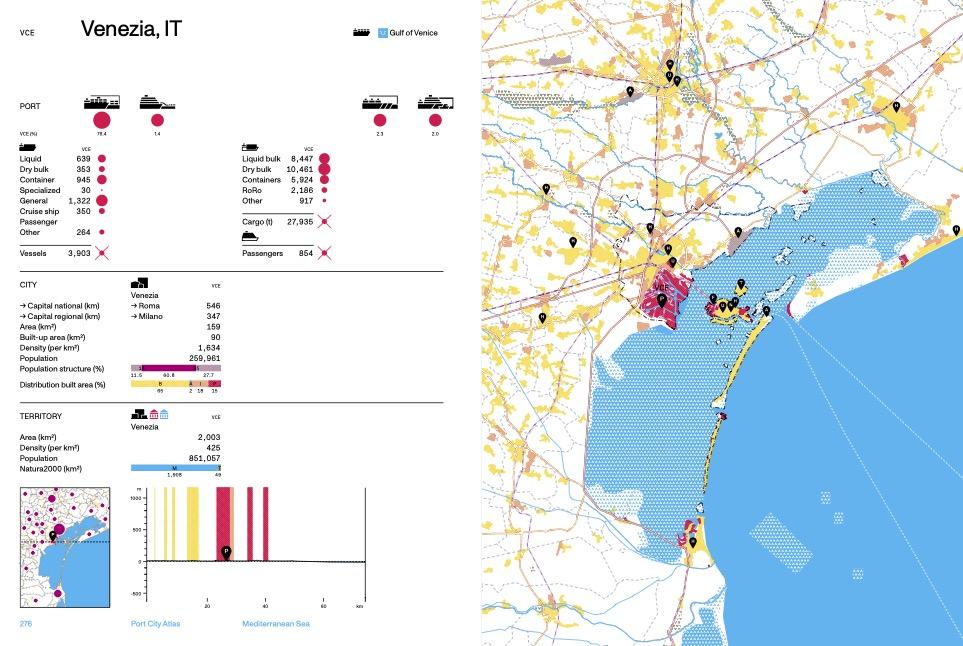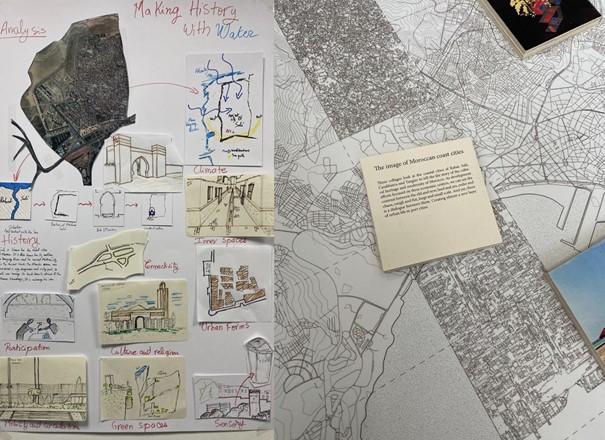Carola Hein and Sabine Luning
Interested in discovering Morocco first-hand while learning about the dynamics of port-city territories through practice? PortCityFutures is hosting a 5-day professional workshop, “Creating a Vision for Port Cities: Workshop and Fieldtrips. Morocco Edition”.
The program combines field visits to Rabat, Salé, Casablanca, Tangier City, and Tangier Med with hands-on learning and expert discussions on strategies for resilient, multifunctional port spaces that reflect diverse stakeholder values.
Sign up here: www.aanmelder.nl/pcfmorocco/home

Sea-ing Africa is a project developed under the leadership of Sabine Luning and Carola Hein, colleagues from the LDE Centre PortCityFutures (PCF) and the Institute of Cultural Anthropology and Development Sociology. The project involves colleagues of Leiden University based at the African Studies Centre and NIMAR (Netherlands Institute Morocco), as well as academic and social partners in Ghana and Morocco (the Institute of African Studies in Accra, the School of Railways and Infrastructure Development in Takoradi, AYA Engineering Ltd, the Architecture Schools of Rabat and Casablanca, the Tanger Med Port Authority and the National Ports Authority of Morocco). The project explores the development of land- and sea-based infrastructure in the context of societal and cultural transformation. It looks at the ways in which shipping, rail and road infrastructure serve the flows of raw materials with ports as nodes and it investigates the impact of these flows on local lives and livelihoods.
The term sea-ing refers to the need to shift our analytical focus from land to sea and explore the ways in which maritime flows impact the spaces of ports, cities and territories. Sea-ing, a term coined by Carola Hein, refers to sea-land perspectives; it makes us aware that many of our approaches focus too singularly on land. This idea emerged from research on the ‘Urbanisation of the Sea’ (Couling & Hein 2020) and conversations with John Hanna and Paolo De Martino with whom we developed the ‘Sea-ing Morocco’ exhibition (displayed at the Venice Biennale), based on the TU Delft course ‘Adaptive strategies' for which fieldwork was organized in collaboration with NIMAR. Connecting this work on Morocco and relating it to the work by Sabine Luning on Ghana inspired successful applications for grants (LUF and LDE Global) to fund Sea-ing Africa.
The notion of sea-ing and the shift to maritime flows as an analytical instrument is closely related to what Carola Hein (2019) calls a port cityscape. This approach posits that the spatial impact of maritime flows is discontinuous and not inscribed in recognized governance or policy frameworks. It foregrounds that port city territories are infrastructural hubs, where economic flows encounter vulnerable ecological terrains. These spaces are at the heart of histories of wealth extraction/accumulation and, due to their location, particularly threatened by climate change. It invites us to shift our focus to the sea and its impact on land transformations. Sea-ing also refers to the act of ‘seeing.’ In practices of planning and the design of infrastructure, visualization is important. In academia too, visualizing is a way to represent and bring together knowledge, spatial dynamics, future outlooks and diversity in stakeholder viewpoints. Methods of seeing are central and teaming up with e.g. photographers is key to this new project.
Sea-ing makes us aware that many of our approaches focus too singularly on land and that a broader perspective is called for in which we look at land from the sea.
Designing
Societal transformation through infrastructure and its societal impact as a design project is a social topic that needs attention beyond technological approaches and siloed practices; the design and building of infrastructure such as ports, highways and railways are embedded in geopolitical shifts, politics and policy cultures, economic regimes and cultural values ingrained in future-making projects affecting all citizens (Addie et al. 2020). We need shared methodologies to achieve understanding and produce more sustainable and equitable practices based on co-creating solutions and designing future scenarios that are locally embedded (OECD 2023).
Infrastructure
In African countries, we are witnessing a ‘re-enchantment’ with big infrastructure, in the tradition of (and building on) colonial legacies. This re-enchantment is driven by geopolitical, financial, political and mineral extractivist concerns and interests (Nugent 2018). These particularly manifest themselves in coastal and port city regions, where national and international actors focus on large-scale infrastructure projects. These interventions create fractured socio-political landscapes and contribute to future-making processes characterized by interruptions and disjuncture (Simone 2004). Ghana and Morocco serve as case studies for the investigation of extractive processes and the role of commodity flows in shaping port city territories. For example, the port of Takoradi was built in colonial times along with railway infrastructure to serve the extraction and export of minerals (manganese, gold) from the hinterlands. Today, there is renewed attention being given to infrastructure in the port and along the railway, but this time these projects also contain facilities for offshore oil exploitation that has been taking place since 2008 in the Atlantic Ocean to the west of Takoradi. These developments require, for example, to see the Western Region of Ghana and the port of Takoradi as the edge of land and sea and to look at land from an offshore perspective.
This research project focuses on the politics of time and temporal dynamics in the design, construction and use of infrastructure. We ask how the past development (including the colonial heritage) of infrastructure features in current debates on the value and promise of infrastructure. How does the framing of ‘development’ in past and present compare, and how can we track the ‘disappearance’, the ‘abandonment’ and the ‘re-emergence’ of infrastructure? Building on transdisciplinary collaborations and methodologies, we are exploring how to establish new design practices and expertise on adaptive strategies in (re)shaping these infrastructures. In addition, we want to trace the chains from making masterplans to micro terrains of building but also contesting infrastructure, while studying actions of planning, funding, governmentality, construction and localized encounters between different land users.
The project will consist of a carefully curated series of research and training activities, integrated with field schools in Ghana and Morocco for MA students from Cultural Anthropology and African Studies at Leiden University. These activities will be open to international researchers and students, including from Delft and Erasmus University. We bring together experts on history, governance, law, culture, planning, design and spatial sciences to develop a variety of methodologies to achieve understanding and co-create more sustainable and equitable practices that are locally embedded. Together, we focus on spatial and temporal processes of planning, designing and realizing big infrastructure for global flows and we examine the impact on local spatial conditions and social arenas. In Ghana, we will do this along the projected Western railway line connecting the port of Takoradi to extractive zones. In Morocco, we will focus on the Tangier-Agadir Corridor, which comprises the Tanger Med Free Zone, a railway and expressway. For research and education purposes, we will identify specific sites and design stages along the proposed railway and along the corridor with a focus on space, people and time.
Our goal is to identify the gaps, connections and disjunctures between narratives of development and change and the in situ social dynamics around harbor and coastal infrastructure along the railway and in the transport corridor. This work will serve as a foundation for new forms of embedded blue and green infrastructural design. We will apply mapping methodologies that we have tested in the open access course (Re)Imagining Port Cities. Each year, we will organize a carefully timed series of events (conference, workshop, field school, exhibition, publication) that will help us refine our transdisciplinary methodology and expand it to include new users and partners in the making of sustainable and socially just infrastructures.
Research methodologies
In our transdisciplinary group, there is extensive methodological expertise in planning and design, as well as in mapping — a key method in academic research. For us, the term mapping includes diverse practices ranging from geospatial mapping to mental mapping and stakeholder mapping. Geospatial mapping will make it possible to portray the historical dynamics, global financial flows and institutional actors that shape the re-enchantments with big infrastructure. The Port City Atlas (Hein, Van Mil & Momirski 2023) will serve as inspiration and learning tool.

Collaborative mapping/visualization with stakeholders is key to analyzing processes in planning and materialization of infrastructure, as well as the iterative movements between visualizations (maps, film footage, future scenarios) and in situ field research along the railway and in the corridor.
The research strategies take inspiration from ‘anthropology as design’, giving explicit attention to flows of events, to people’s aspirations and to the role of visualizations in foregrounding these processes and perspectives (Otto & Smith 2020). In this, we build on recent experiences gained in a studio that was jointly organized by PCF and NIMAR and by artistic collaborations in the Gold Matters project (Fisher et al. 2023, Luning & Pijpers 2022).

Acknowledgement
This blog has been written in the context of discussions in the LDE PortCityFutures research community. It reflects the evolving thoughts of the authors and expresses the discussions between researchers on the socio-economic, spatial and cultural questions surrounding port city relationships. Special thanks for comments and reviews to Vincent Baptist.
References
Addie, Jean-Paul D., Michael R. Glass, and Jen Nelles. 2020. “Regionalizing the Infrastructure Turn: A Research Agenda." Regional Studies, Regional Science 7 (1): 10-26.
Couling, Nancy, & Carola Hein. 2020. The Urbanisation of the Sea: From Concepts and Analysis to Design. NAi010 Publishers.
Fisher, Eleanor, Sabine Luning, Nii Obodai, Carlos H. X. Araujo, Jorge Calvimontes, Ester van de Camp, Lorenzo D'Angelo, Cristiano Lanzano, Luciana Massaro, Januaria P. Mello, Alizèta Ouedraogo, Januária Perreiro Mello, Robert Jan Pijpers, Raisa Resenda de Moraes, Christophe Sawadogo, Marjo De Theije, Giorgio de Tomi, and Ronald Twongyirwe. 2023. Gold Matters: Visualizing Mining Worlds. Nordiska Afrikainstitutet.
Hein, Carola. 2019. “The Port Cityscape: Spatial and Institutional Approaches to Port City Relationships.” PORTUSplus 8: 1-8.
Hein, Carola, Yvonne van Mil, and Lucija Ažman Momirski. 2023. “Port City Atlas. Mapping European Port City Territories: From Understanding to Design.” NAi010 Publishers.
Luning, Sabine, and Robert Jan Pijpers. 2022. “Drawing on Words and Images: Collaborations in the Anthropology of the Underground.” Anthropology and Photography 16. https://www.therai.org.uk/images/stories/photography/AnthandPhotoVol16.pdf.
Nugent, Paul. 2018. “Africa’s Re-enchantment with Big Infrastructure: White Elephants Dancing in Virtuous Circles?” In Extractive Industries and Changing State Dynamics in Africa, 22-40. Routledge.
OECD. 2023. Localising the Blue Economy: Towards a Resilient, Inclusive, Sustainable and Circular Approach to the Blue Economy in Cities and Regions. https://survey.oecd.org/index.php?r=survey/index&sid=749368&lang=en
Otto, Ton, and Rachel Charlotte Smith. 2020. “Design Anthropology: A Distinct Style of Knowing.” In Design Anthropology, 1-29. Routledge.
Simone, A.M., 2004. For the city yet to come: changing African life in four cities. Duke University Press.
